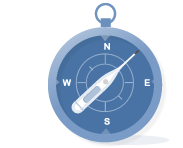
A guide to the world of blood pressure monitors
You need to buy a blood pressure monitor, but you don't know which one to choose. Here's a guide to the various types, to help you find the right one for your everyday situation: the pros and cons of each one, how accurate and easy to read they are, and whether they're safe.
The mercury sphygmomanometer, introduced around 100 years ago, is the gold standard of blood pressure monitors. Since 3 April 2009, it has been banned from retail sale because mercury is toxic and difficult to dispose of. Let's look at the alternatives best suited to your needs.
Aneroid monitors: convenient and fairly accurate
This type of manual monitor is used for the auscultatory measurement of blood pressure. It has a mechanical system of levers and springs and a series of levels that show the pressure on a circular dial. Like all manual monitors, it is used with a stethoscope. It is quite fragile, especially if not treated with due care, and needs to be recalibrated at least once a year. The manual monitor is smaller and easier to transport than other models, but you should know that it's complicated to use on your own.
Hybrid models: safe, but not 100% reliable
Hybrid blood pressure monitors have some of the traditional disadvantages of the auscultatory method, such as underestimating systolic and overestimating diastolic pressures. However, they also combine the advantages of manual devices (strength and safety) and digital automatic ones (error reduction). These monitors have an electronic transducer that measures the air pressure in the cuff and displays it on an analogue screen, a column with a digital LED simulating mercury, or on a digital scale, by showing the air pressure in the cuff in the form of numbers running across the screen as the cuff deflates.
Digital automatic and semiautomatic monitors: easy to use, but some disadvantages
Automatic and semiautomatic monitors calculate blood pressure by recording pressure fluctuations inside the cuff at different stages of the measurement process, as it inflates and deflates. They can do this even in noisy conditions, and provide accurate readings without a "training" period. Result? They're very easy to use, and the readings are extremely easy to understand. But bear in mind that they have some disadvantages, such as possibly inaccurate readings in patients with arrhythmia, and are susceptible to mechanical vibration while taking the reading.
Manual and digital automatic blood pressure monitors: a comparison
Manual monitors are the most difficult to use, and are usually the exclusive preserve of medical and health professionals. Before buying one, you need training in how to carry out accurate auscultation. But is it really worth the effort? Keep in mind that digital automatic monitors require no special expertise, and are just as reliable as manual ones.










